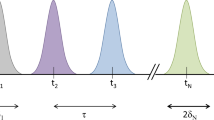Abstract
In this fourth paper in a series on stochastic electrodynamics (SED), the harmonic oscillator-zero-point field system in the presence of an arbitrary applied classical radiation field is studied further. The exact closed-form expressions are found for the time-dependent probability that the oscillator is in the nth eigenstate of the unperturbed SED Hamiltonian H 0 , the same H 0 as that of ordinary quantum mechanics. It is shown that an eigenvalue of H 0 is the average energy that the oscillator would have if its wave function could be just the corresponding eigenstate. The level shift for each unperturbed eigenvalue is found and shown to be unobservable for a different reason than in the corresponding QED treatment. Perturbation theory is applied to the SED Schrödinger equation to derive first-order transition rates for spontaneous emission and resonance absorption. The results agree with those of quantum electrodynamics, but the mathematics is strikingly different. It is shown that SED demands discarding the ideas of quantized energies, photons, and completeness of the Schrödinger equation, Finally, an intuitive physical SED model is suggested for the photoeffect and for Clauser's(2) coincidence experiment.
Similar content being viewed by others
References
M. D. Crisp and E. T. Jaynes,Phys. Rev. 129, 1253 (1969).
J. F. Clauser,Phys. Rev. D 9, 853 (1974).
George Arfken,Mathematical Methods for Physicists (Academic Press, New York, 1970), Chapter 13.
L. I. Schiff,Quantum Mechanics (McGraw-Hill, New York, 1968), 2nd edn., Chapter 4.
J. J. Sakurai,Advanced Quantum Mechanics (Addison-Wesley, Reading, Massachusetts, 1973), Chapter 2.
J. H. Eberley, inFoundations of Radiation Theory and Quantum Electrodynamics, A. O. Barut, ed. (Plenum, New York, 1980), pp. 23–35.
E. Santos,Nuovo Cimento B 19, 57 (1974).
W. E. Lamb, Jr., and M. O. Scully, inPolarization, Matter, and Radiation: Jubilee Volume in Honor of Alfred Kastler, Société Francaise de Physique, ed. (Presses Universitaires de France, Paris, 1969), pp. 363–369.
E. Wigner,Phys. Rev. 40, 749 (1932).
L. Cohen,J. Math. Phys. 7, 781 (1966).
M. D. Srinivas and E. Wolf,Phys. Rev. D 11, 1477 (1975).
L. de la Peña-Auerbach and A. M. Cetto,Found. Phys. 8, 191 (1978).
C. A. Kocher and E. D. Commins,Phys. Rev. Lett. 18, 575 (1967).
A. Aspect, P. Grangier, and G. Roger,Phys. Rev. Lett. 47, 460 (1981).
M. O. Scully, inFoundations of Radiation Theory and Quantum Electrodynamics, A. O. Barut, ed. (Plenum, New York, 1980), pp. 45–48.
T. W. Marshall,Izv. Vyssh. Uchebn. Zaved., Fiz. 11, 34 (1968) (in Russian); translation inSov. Phys. Izvestiya.
T. W. Marshall,Proc. R. Soc. (London) A 276, 475 (1963).
Author information
Authors and Affiliations
Rights and permissions
About this article
Cite this article
Goedecke, G.H. Stochastic electrodynamics. IV. Transitions in the perturbed harmonic oscillator-zero-point field system. Found Phys 14, 41–63 (1984). https://doi.org/10.1007/BF00741646
Received:
Issue Date:
DOI: https://doi.org/10.1007/BF00741646




